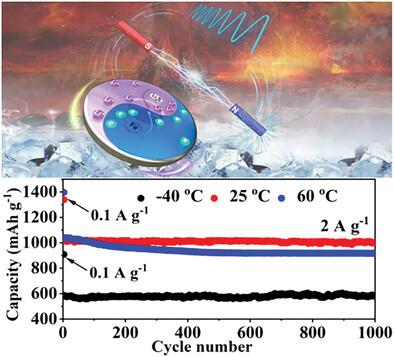当前位置:
X-MOL 学术
›
Adv. Energy Mater.
›
论文详情
Our official English website, www.x-mol.net, welcomes your
feedback! (Note: you will need to create a separate account there.)
Hollow Microsphere Structure and Spin‐Polarized Surface Capacitance Endow Ultrafine Fe7S8 Nanocrystals with Excellent Fast‐Charging Capability in Wide‐Temperature‐Range Lithium‐Ion Batteries
Advanced Energy Materials ( IF 24.4 ) Pub Date : 2024-11-15 , DOI: 10.1002/aenm.202403851 Meisheng Han, Kunxiong Zheng, Jie Liu, Zhiyu Zou, Yongbiao Mu, Hengyuan Hu, Fenghua Yu, Wenjia Li, Lei Wei, Lin Zeng, Tianshou Zhao
Advanced Energy Materials ( IF 24.4 ) Pub Date : 2024-11-15 , DOI: 10.1002/aenm.202403851 Meisheng Han, Kunxiong Zheng, Jie Liu, Zhiyu Zou, Yongbiao Mu, Hengyuan Hu, Fenghua Yu, Wenjia Li, Lei Wei, Lin Zeng, Tianshou Zhao

|
Fe7 S8 as a conversion‐type anode shows high capacity in lithium‐ion batteries (LIBs). Nevertheless, the sluggish ion transport rate, low electron conduction behavior, and large volume change upon cycling limit its applications in fast‐charging wide‐temperature‐range LIBs. Here, a simple hydrothermal and subsequent solid‐phase high‐pressure sulfidation route is proposed to synthesize a hollow Fe7 S8 /N‐doped C microsphere structure. The hollow space is enveloped by the spheres’ shell consisting of ultrafine Fe7 S8 nanocrystals (≈8 nm) embedded into N‐doped C matrix, which enhances ion transport and electrical conduction, and accommodates the volume expansion of Fe7 S8 . Remarkably, in situ magnetometry reveals that spin‐polarized surface capacitance occurs during the stage of conversion reaction, in which the formed Fe and Li2 S act as electrons and ions acceptor, respectively, to construct space charge zone at their interfaces, thus enhancing lithium transport and storage. Accordingly, the hollow microspheres show high gravimetric energy density and outstanding fast‐charging capability along with excellent cycling stability in Ah‐level pouch cells operating from ‐40 to 60 °C. For the first time, this work confirms the effectiveness of spin‐polarized surface capacitance effect on enhancing ion storage and transport in fast‐charging wide‐temperature‐range LIBs.
中文翻译:

空心微球结构和自旋极化表面电容赋予超细 Fe7S8 纳米晶体在宽温度范围锂离子电池中出色的快速充电能力
Fe7S8 作为转换型负极在锂离子电池 (LIB) 中显示出高容量。然而,缓慢的离子传输速率、低电子传导行为和循环时较大的体积变化限制了其在快速充电宽温度范围 LIB 中的应用。在这里,提出了一种简单的水热和随后的固相高压硫化路线来合成空心 Fe7S8/N 掺杂 C 微球结构。空腔被球体外壳包裹,该球体壳由嵌入 N 掺杂 C 基体中的超细 Fe7S8 纳米晶体 (≈8 nm) 组成,增强了离子传输和导电,并容纳了 Fe7S8 的体积膨胀。值得注意的是,原位磁力测量揭示了自旋极化表面电容发生在转换反应阶段,其中形成的 Fe 和 Li2S 分别充当电子和离子受体,在它们的界面处构建空间电荷区,从而增强锂的传输和存储。因此,空心微球在 -40 至 60 °C 的 Ah-level 软包电池中表现出高重量能量密度和出色的快速充电能力以及出色的循环稳定性。 这项工作首次证实了自旋极化表面电容效应对增强快速充电宽温度范围锂离子电池中离子存储和传输的有效性。
更新日期:2024-11-15
中文翻译:

空心微球结构和自旋极化表面电容赋予超细 Fe7S8 纳米晶体在宽温度范围锂离子电池中出色的快速充电能力
Fe7S8 作为转换型负极在锂离子电池 (LIB) 中显示出高容量。然而,缓慢的离子传输速率、低电子传导行为和循环时较大的体积变化限制了其在快速充电宽温度范围 LIB 中的应用。在这里,提出了一种简单的水热和随后的固相高压硫化路线来合成空心 Fe7S8/N 掺杂 C 微球结构。空腔被球体外壳包裹,该球体壳由嵌入 N 掺杂 C 基体中的超细 Fe7S8 纳米晶体 (≈8 nm) 组成,增强了离子传输和导电,并容纳了 Fe7S8 的体积膨胀。值得注意的是,原位磁力测量揭示了自旋极化表面电容发生在转换反应阶段,其中形成的 Fe 和 Li2S 分别充当电子和离子受体,在它们的界面处构建空间电荷区,从而增强锂的传输和存储。因此,空心微球在 -40 至 60 °C 的 Ah-level 软包电池中表现出高重量能量密度和出色的快速充电能力以及出色的循环稳定性。 这项工作首次证实了自旋极化表面电容效应对增强快速充电宽温度范围锂离子电池中离子存储和传输的有效性。


















































 京公网安备 11010802027423号
京公网安备 11010802027423号